Commercial Plant Disease
-

Agente causal, céspedes susceptibles,condiciones que promueven la enfermedad, síntomas y control de mancha parda, mancha dólar, quemazón por Pythium, mancha foliar por Helminthosporium, marchitamiento por Curvularia, mancha foliar gris, anillo de hada, enfermedad toma-todo o pudrición radicular por Gaeumannomyces, roya, hongos gelatinosos y nematodos.
Alfredo Martinez and Leon Burpee
|
-

Stripe rust is an emerging disease in the state of Georgia. Evidence of increased aggressiveness of the disease has been reported recently. Rusts are the most economically important group of wheat diseases. More than $5 billion is lost to cereal rusts worldwide each year.
James Buck, Alfredo Martinez, and John Youmans
|
-

In the state of Georgia, gray leaf spot primarily affects St. Augustinegrass and is particularly chronic and damaging in the coastal area of the state. This publication contains important information on the biology of the causal agent, detailed descriptions and photos of the disease symptoms, information on conditions favoring the disease, as well as cultural, genetic, and chemical methods of control. The publication is intended for turfgrass professionals, consultants, county faculty, homeowners, and the general public.
Jacob Price, Elizabeth Little, Alfredo Martinez, and Donald Gardner
|
-

Mancha dólar es una enfermedad omnipresent en cespedes de clima calido y frio en el estado de Georgia. La publicacion contiene informacion importante en la biologia del gente causal, descripcion detallada de los sintomas de la enfermedad (con fotografias de alta definicion), informacion relevante y reciente en las condiciones que favorecen la enfermedad, asi como los metodos de control cultural, genetico y quimico. Esta publicacion es dirigida a profesionales, consultores, agentes de extension y publico en general.
Alfredo Martinez
|
-

Fusarium Head Blight (FHB), also called scab, is a devastating disease that is emerging in Georgia wheat fields. This publication contains important information on the biology of the causal agent, and conditions that favor the disease, detailed descriptions of the diseases symptoms, and the latest information on cultural, genetic, and chemical methods of control. The intended audience is producers, professionals, consultants, county faculty and the general public.
W. (Rome) Ethredge, James Buck, Alfredo Martinez, Christopher Vermeer, and John Youmans
|
-

La mancha larga causada por Rhizoctonia es una de las enfermedades mas comunes y severas de cespedes de clima calido en georgia y en los Estados Unidos. La publicacion contiene informacion importante en la biologia del gente causal, descripcion detallada de los sintomas de la enfermedad (con fotografias de alta definicion), informacion relevante y reciente en las condiciones que favorecen la enfermedad, asi como los metodos de control cultural, genetico y quimico. Esta publicacion es dirigida a profesionales, consultores, agentes de extension y publico en general.
Alfredo Martinez
|
-

Landscape professionals must consider many factors when choosing the right flowering annuals to plant for a particular location. Primary considerations include high visual impact, consistent bloom for color, foliage for texture and color, sun exposure, growth habit and low-water tolerance. Cost plays an important role as well. Many landscapers typically choose common annual ornamentals and tropical perennials marketed as annuals. Particular species and cultivars tend to be favored over others for a variety of reasons; these are the bread-and-butter plants, such as cool-season pansies and warm-season petunias. Because of this, staple plants tend to be planted year after year, often in the same bed – a recipe for disease build-up, pesticide applications, loss of plants, plant replacement, dissatisfied customers, and ultimately, lower profit margins. This publication explains how to effectively use crop rotation and cultural practices to reduce disease incidence in seasonal color beds.
Jean Williams-Woodward and Svoboda Pennisi
|
-

C 1253
Phony Peach Disease
This fact sheet covers phony peach disease: History, symptoms, disease cycle, and management.
Phillip Brannen and Kendall Johnson
|
-

The 2021 Southeast Regional Caneberry Integrated Management Guide covers topics such as pesticide stewardship and safety, insect and disease control, pre-transplant and transplant operations, fungicide and insecticide efficacy comparisons and spray schedules, weed management, wildlife damage, and more. Recommendations are based on information from the manufacturer’s label and performance data from research and extension field tests. Because environmental conditions and grower application methods vary widely, suggested use does not imply that performance of the pesticide will always conform to the safety and pest control standards indicated by experimental data. This publication is intended for use only as a guide. Specific rates and applications methods are on the pesticide label, and these are subject to change at any time.
Phillip Brannen
|